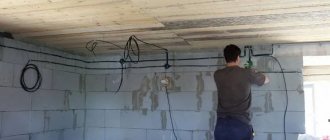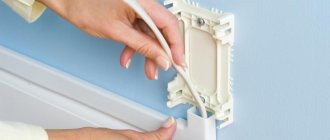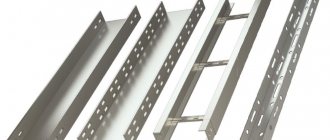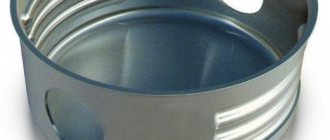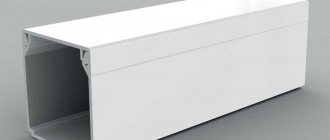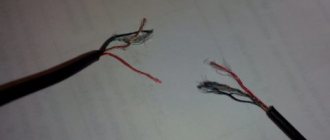Every decade, builders, electricians, and installers have found their work more convenient and easier. New materials and tools appear. They make professional work easier; installation is carried out not only with high quality, but also at an accelerated pace.
Today we will continue the topic of the emergence of new options on the installation market - in particular, this is a dowel-clamp for attaching a cable.
Clamps on the wall: durable, aesthetically pleasing
So, dowel clamps, or staples in other words: what kind of device is this? What are they made of, how much are their options in demand both by professionals and by everyone who makes something for themselves around the house or dacha. And most importantly: how firmly do they hold the attached materials, how much do they cost?
Read below for answers to these questions about this dowel for open laying of any type of cable, its restoration and quick replacement.
Construction mixture
Used for hidden cable laying in wall and ceiling grooves. For this, gypsum mortar is often used. This type of installation has a special name - “freezing”. There is nothing complicated about this method. An alabaster mixture is made and the cable is tacked in the groove in places evenly spaced from each other. This should be done promptly, since the plaster sets quickly enough.
Plaster solution for fastening wiring
This “freezing” is well suited for installation of a single cable in a groove. But this method is also used as an additional fastening of several cables, to secure already installed brackets, dowels, clamps, etc. After all this, the groove channels are filled with plaster mortar.
If the laying volumes are large, frequent preparation of the solution and fixation of the cable significantly reduces the installation speed. But in many cases this is completely justified.
Design Features
Electrical cables are attached to brick, plasterboard and aerated concrete walls or reinforced concrete or wooden ceilings of premises using just such adjustable fasteners. It then needs to be secured in the drilled hole. As a result, the dowel-clamp is driven inside, and its bracket holds the wiring on it from the outside.
So, the design of this fastening option is a strip of plastic up to ten millimeters wide, bent like a bracket. It is the bracket that has the most options on products - no matter what its shape!
And in the form of the letter “C” of different sizes, with continuing fasteners, and ellipses - large and small - with the same legs for round wire. A dowel clamp for flat cable (two-core aluminum) is also widely used.
At the end of the legs of such dowels, teeth are cast. They are in the hole and will not allow him to turn. And this is a guarantee that your wire on the outer wall will not be torn out by a gust of wind.
There are dowels of various colors on sale, and the question arises: is a white dowel clamp better or a black one? They are the same, buy by color and take into account the color of the cable or wiring base.
Hidden electrical installation
When installing electrical wiring in a hidden way (in a groove under the plaster), there are more options for attaching wires and cables to the walls. Let's consider from the most simple and effective to the least convenient.
Dowel clamps
Dowel clamps, in fact, like dowel ties, are very convenient to use. These fasteners are low cost and also allow for quick electrical installation. Ties, of course, are more practical and versatile, so we recommend choosing them for fastening wires in a groove. All you need to do is drill a hole in a concrete, brick or wooden surface, insert a special dowel tie into it, and then drive in a special expansion peg.
Attaching a dowel clamp to the wall is even easier. You just have to drill a hole and then hammer the cable tie into it, as shown in the picture below. To attach the wire to drywall, we recommend using a special butterfly dowel into which the fasteners are already screwed (second picture).
By the way, if you already have electrical wiring along the walls and you need to attach another cable to it, you can use ordinary plastic clamps. For fastening in this way outdoors, it is recommended to use black clamps that are resistant to ultraviolet radiation!
Technology for fastening special staples
Using special ties
Quick drying solution
In order to quickly fasten wires and cables in the groove, you can use a quick-drying solution: alabaster or gypsum. In this case, you need to act hastily, because... the finished solution hardens very quickly, and you may not have time to fix the entire selected area in the wall. As a rule, the cable needs to be “frozen” in the prepared groove every 40 cm, as shown in the photo.
The advantage of this method of fastening the wire is that you do not need to spend much on material and, moreover, you can do without nails and without drilling walls. The main disadvantage is that the solution hardens quickly, so you need to dilute plaster or alabaster in small volumes. In addition, attaching more than two conductors to the wall will be very difficult.
Homemade staples
Fastening the cable to the wall using brackets will ensure reliable gripping of the conductor, and will also allow you to secure several groups of cables in one route. In order to attach conductors with brackets, you must first make these fasteners yourself. In this case, you will need either thin galvanized steel, cut into strips, or PTPZh aluminum wire. The length of each staple should be from 6 to 7 cm. You need to cut the material into suitable pieces, and then drill a suitable hole in the center of each. Then everything is simple - the wall is drilled in suitable places, after which the dowel is driven in and “quick installation” is carried out. You can also hammer the staples with nails if the fastening is carried out on wooden walls.
The disadvantages of this method are the long preparation time for homemade staples, the likelihood of damage to the conductor insulation (if strips of galvanized steel are used), as well as the possible appearance of red spots on the wallpaper if the steel begins to oxidize. We do not recommend using this option if you need to secure the wire in the wall under plaster, because... There are more modern and convenient installation methods. It is reasonable to use brackets to attach the heating cable of a heated floor system.
Installation site
Well, the last, one of the modern options that will allow you to fix the wire on tiles or furniture (for example, a table) is the use of mounting pads with one self-adhesive side (Velcro). Everything is very simple here, so there is no point in explaining the essence of the fastening. You can see the installation sites in the photo:
That's all the ways to attach wires and cables to the wall. As you can see, there is a wide range of fasteners that will allow you to choose the most suitable option for various application conditions.
Also read:
Errors when installing electrical wiring Methods for connecting electrical wires How to determine phase and zero without instruments
Helicopters, Christmas trees and bedbugs
There are other design features. A dowel clamp with a spacer rod is used for round cables. In everyday life it is called a “helicopter”. Withstands significant loads and allows you to attach massive and heavy objects
A bracket with teeth and a flat head is called a “herringbone” - this is a dowel clamp for a flat cable. This fastening is carried out on materials with medium density.
To suspend heavy cables, you need to use metal dowel clamps, one of which is called a “bug.”
Staples and clips
Clamps are usually used to secure low voltage cables. Such fasteners can have a U or L-shaped design. Depending on the thickness of the cable, staples of the appropriate size are selected.
It is better to use staples with a plastic casing, this minimizes the risk of damage to the insulation. But, for wiring even a household electrical network, this type of installation is not recommended. This is the optimal solution for laying computer networks, telephone lines, etc.
A clip for fastening wires is a special steel or plastic structure through which cables are installed. Plastic clips are used when performing interior work.
Steel clips are suitable for use in open areas. It is best to use stainless steel fasteners, they are the most durable. Coated with paint or a layer of zinc are also strong, but less durable.
The most aesthetic and inconspicuous type of clip is a compact plastic clip with a nail. Such fasteners provide quick installation and are well suited for laying a single cable. Staples for thick wires or bundles of wires are more visible, but provide greater security.
Material for dowels
What are dowels made of? All materials can be divided into two groups – polyamide and polyester.
Nylon is a representative of the first group. It is the most popular material for creating dowels. Polyamides are stronger than others and can withstand more cable weight. A nylon dowel clamp is better when the polyamide is treated with halogens and becomes stronger. But also more expensive.
There is one drawback. Polyamide can withstand temperatures up to 90 degrees Celsius and the elongation is reduced several times. This situation is not dangerous for electrical cables laid through them. But not for PVC pipes with hot liquid. For them, you need to select dowels from a different material.
Polyethylene is a budget fastener, but it is damaged by solar ultraviolet radiation. This must be taken into account and purchased for external wiring dowels from the stabilized version. But even such a dowel loses strength over time.
Thermoplastic polymer - fasteners made from it hold the pendants more reliably than those mentioned above, but are also vulnerable to ultraviolet radiation. Stabilization of polypropylene strengthens the material, but also increases its price. It is more for interior work.
How to fasten
Before final finishing of the walls, you need to choose a method for fixing the wires.
Alabaster
Gypsum composition is used when it is necessary to quickly fasten the cable. The solution holds a small number of soft braided wires. Alabaster is applied in small portions. The main disadvantage is the rapid hardening of the mixture, which cannot be prepared in the required volumes.
Cable ties
Non-flammable plastic fasteners are suitable for installation on aerated concrete, brick, wood or concrete. It is used in combination with screws, screws and dowel nails. Before installation, a hole corresponding to the diameter of the fastener is formed. After this, the dowel is inserted, the tie-plate is hammered in, and the cables are laid on the finished route.
Dowel-ties
The product is a dowel-nail with a screed made of self-extinguishing plasticizers. The fasteners are equipped with one-piece or detachable locks. In the second case, you can supplement the bundle with new wires or remove unnecessary elements. Dowel ties are used for open or hidden laying of cables on brick or concrete surfaces.
Plastic dowel
Polyamide nails with a hole head help to quickly secure the cable in the groove. First, the fixing element is hammered in, then the cable is pulled through.
Dowel clamps
Products of different diameters are offered in white or black. The fastener has the form of a loop with clamps on the legs. Before installation, a groove is made, a clamp is placed, and wiring is laid. The disadvantage of this method is the need to strictly select the size of the fastener for the cable cross-section.
Dowel clips
The elements are used for open laying of wires. They look like curved strips with branches. Clips are suitable for securing small round or flat cables. Such elements are easy to install. It is enough to make a niche of the required size and insert a tourniquet into the clip. Electrical communications are fixed securely and look aesthetically pleasing.
Homemade devices
In the absence of specialized products, you can use improvised means:
- Dowels or nails. They are driven in before laying the wiring. A nail is used to pierce the central part of the telephone cable.
- Corrugated hose. It is cut into pieces, the length of which is slightly greater than the width of the channel. The tube is compressed and inserted into the groove. As the wall is plastered, the fasteners are removed.
- Perforated metal strips. Used to place across the pipe and secure bundles.
Aluminum plates
To secure the cables, sheets of metal cut into thin strips are used. Several wires are wrapped in a plate, which is drilled and secured to the bottom of the groove. The ends of the strip are folded after laying the cables.
Fasteners for organizing a bundle of conductors
When organizing workplaces, several different cables are checked.
To arrange the beams use:
- Installation sites. They are fixed to the surface using an adhesive layer. After this, the bundle is attached to the site using a standard tie.
- Cable clip with adhesive backing. It is suitable for fixing to plastic surfaces.
- Cable trays made of perforated metal, fixed to the ceiling.
Pros and cons of dowel clamps
Advantages:
- economical - there is only one part in the fastener compared to dowels and dowel-nails;
- ease of installation and its speed;
- quick and easy repairs;
- reliable cable fastening.
Flaws:
- not flammable, but deforms with sufficiently strong heating, both internal (through the cable) and external;
- not suitable for apartments due to open hanging of wires and cables.
Advantages and disadvantages
The use of dowel clamps has many positive aspects. This fastener is very economical, since it replaces 3 parts at once: a clamp, a dowel and a screw, and it is also easy to install - just install it in the drilled hole.
Despite the fact that this fastener looks thin and not very reliable, in fact it is able to withstand a significant weight of cables and pipes.
This fastener also has some disadvantages. Despite the fact that the material from which plastic clamps are made supports combustion and can withstand very high temperatures, it can still be deformed when exposed to it.
Also, such fastening of wires is not very aesthetically pleasing, so it only occurs in industrial or non-residential premises.
How to use it technologically
Dowel clamps are intended for cable laying only. But it should be no thicker than 2.5 centimeters.
When choosing, consider the following factors:
- select the diameter of the clamp for each cable. A 10-15 mm clamp will not support a 20 mm cable;
- pay attention to the shape of the clamp - whether the cable will be flat or round, choose dowels for them;
- Date of issue. The dowel-loop is designed for one and a half to two years of operation. But not from the moment of installation, but from production.
Why is the wiring fixed?
There are many different ways to install electrical wiring, but no matter what you choose, it must be secured. Even in the case of hidden installation in grooves made in the vertical or horizontal plane of the wall, the cable should be securely fastened, and then the holes should be plastered. Not a single wire should extend beyond the edges of the grooves and interfere with plastering and finishing.
The situation is similar for an open gasket. The cable must be securely fastened along the entire length of the electrical line, and only then hidden inside corrugations, special boxes and other decorative items. The same should be done when laying behind suspended and suspended ceilings.
You can attach the wire to almost any wall - brick, plasterboard and wood. To perform work using dowel clamps, it is advisable to prepare a drill or hammer drill with a set of suitable drills.
Price issue
Fastening materials are sold separately or included with the cable or PVC pipe. The price of a dowel clamp is determined by the material and design features.
A plastic clamp is estimated at 50-73 rubles. for a hundred. Metal fasteners will cost several times more.
“Helicopter” goes for sixty for the same quantity. Dowel clamp 5 (10) white for the same price and wholesale - 40 rubles.
Methods of fastening to walls made of various materials
It is a mistake to believe that wiring can be fixed to any flat surface. Load-bearing structures and partitions are constructed from materials with different properties:
- thin, soft;
- dense;
- solid.
Wall surfaces made of porous materials (foam, aerated concrete) are considered soft. This group also includes plasterboard, plastic, and fiberboard. These materials are able to withstand moderate loads, but are deformed under the influence of strong pressure. To prevent destruction of the entire structure, you should choose methods for attaching the cable to the wall based on the use of fasteners that have an extended middle/end part. These can be dowels of different types.
The group of dense materials includes chipboard, wood, and gypsum. Surfaces covered with plaster are also durable. The top layer of the material has a dense structure. If the question of how to fix the cable on such a wall is being decided, two options are considered: nails, self-tapping screws.
The first one is less reliable. Such fasteners can be dispensed with if they are used as a temporary measure or if this area will not be used in the future. Due to mobility, the strength of fixation of the nail in the wall decreases. To secure the screws, holes of a smaller diameter are first made. However, this measure is used only if the fasteners are difficult to install.
Solid materials: concrete, brick. On such walls, dowels are attached, and then holders with screws (staples, clamps, ties, etc.). When you need to install a cable on a brick or concrete wall, the diameter of the hole must correspond to the size of the dowel. In other cases, the difference should be 1 mm.
Photo of dowel clamps
Installation of wiring in the groove
For any type of installation of electrical wiring and cables, the same types of fasteners can be used. It is selected based on the existing conditions, capabilities and tastes of the owners.
The main task is to ensure high-quality fixation and not to disturb the insulation either during installation or during further work and operation. And you select the type of fastening from the possible options.
There are quite a lot of them - there are special ones that are produced specifically for cables, there are those borrowed from other areas, and there are homemade ones.
Dowel clamp
Plastic dowel cable clamps are designed to secure a single cable. It is very simple to secure the cable dowel with a clamp. To do this, we just need a hammer drill and a concrete drill with a diameter of 6 mm.
There are notches on the sides of the clamp at an angle, which prevents it from falling out of the wall. If the size of the drill and clamp are chosen correctly, the dowel will never fall out of the hole.
The dowel clamp for fastening the cable can be in two versions: for flat and round cable.
The positive aspects are low cost, quick installation method, reliable fixation (you can be sure that the cable will not break under its own weight).
Using a dowel clamp, the cable can be fastened to concrete, brick, foam block, and decorative stone. Suitable for both open and hidden fixation of wires.
This type of fastening is sometimes called a dowel-clip or dowel-bracket.
Dowel clip
A dowel-clip is more invisible during installation. This is a curved strip of plastic with characteristic branches at the ends, which, due to elastic force, will hold the fasteners in the wall or ceiling material.
The shape of these products is available for round and flat cables of different sizes. But you can’t secure serious cables with them—they’re too small. But they look very neat on conductors of small cross-sections, including television, telephone and Internet.
Dowel tie
Another option for quickly attaching the cable is a dowel tie. It is made from non-flammable, self-extinguishing plasticizers and allows for quick installation of cable lines. Can be used for both open and hidden installation.
A dowel tie is a quick and convenient way to secure a cable to concrete, brick and other surfaces.
There is a coupler with a detachable and permanent lock. The detachable lock allows you to change the number of wires if necessary. The installation method is the same as for a regular dowel. The difference is that the dowel here is also plastic.
Cable clips come in plastic and metal.
Metal brackets for cable fastening
As a rule, this method is used to fasten cables laid in a metal sleeve. Metal brackets have a hole for fastening on one or both sides. The size of the staples can be selected depending on the diameter of the metal hose. Excellent resistance to mechanical stress, suitable for “holding” heavy cables.
The advantage is that it is “reusable”. You can easily replace, rearrange, add or remove a cable, you just need to unscrew the screw.
- This method has two advantages that are unattainable for other fastening methods:
- Reliable fixation, thanks to which the cable can be pressed very tightly to the surface.
- Fixing several parallel cables; this does not require drilling a bunch of holes, and a long fastening bracket can grab and fix 3-4 (or even more) cables at once.
We suggest you familiarize yourself with How to make stone wool
Double-core aluminum noodles or PTPG are a stiffer wire, usually used as staples. The bracket itself is attached to the wall using “quick installation” (6 x 40 or 6 x 60) or using construction nails (if the walls are made of gas silicate).
Plastic bracket for cable fastening
As a rule, it is used for open installation of single cables. The plastic bracket is equipped with a nail for fixation; therefore, it is suitable for installation on soft surfaces such as wood, chipboard, plastic (you cannot hammer such a nail into concrete).
In my practice, I have often seen television and telephone cables fastened using this method. Providers are very fond of using plastic staples to secure Internet cables.
Mounting order
The electrical wiring in the apartment has a tree-like structure, consisting of branches to sockets and switches. All wires are connected to the panel. Therefore, they begin attaching wires to the wall from the end of the routes: distant sockets, switches and split systems. What does the installer need to have with him?
Calculation of cable cross-section
Pocket tools for installing home cable line:
- cable cutter and stripper;
- stationery knife for cutting out seals in junction boxes;
- a small two-hundred-gram hammer for nailing dowel clamps;
- a pack of dowel clamps;
- screeds;
- white marker for writing on black cables.
First you need to fold the coils of wires near the shield. From there, unwinding the required length of cables begins. Unwinding is carried out so that the flat cable lies flat and does not twist. They like to work with a flat cable because it deviates in only two planes: right and left. The round wire can rotate and bend in any direction.
The cable is fixed at the farthest point, measured and cut to the length of the shield. The name of the electrical receiver is signed with a marker. In this way, all subsequent cable lines are prepared.
Necessarily! All ends of group cables from switches, lamps inside distribution boxes are signed. This will further reduce the time when assembling the box.
After completing the cable laying on the ceiling, drops are made from the box to the switch or socket. They are not performed right away, because it is inconvenient to do it from above.
Fastening with cable clamp
A cable clamp is used to secure and hold a wire or cable in difficult areas of the route. Cable clamps are used for all varieties of cables, ranging from very small consumer electronics and small diameter telephone wires, to large diameter, heavy duty electrical conductors, rope and metal cables.
Cable clamps are used when laying cables in basements and in many other cases. There is a wide range of clamp types and sizes available. The cable clamp is made of stainless steel or durable plastic. Using a cable clamp eliminates the need for adhesive tapes and cable ties.
The universal type of cable clamp consists of a round hole in which the cable is secured and a securing flange with holes for a nail or screw. This type of clamp, made of stainless steel or plastic, usually has a soft sheath to protect the wire. The plastic clamp is the most economical but less durable to hold. For heavy-duty applications that require greater strength and durability, a metal cable clamp should be used.
Another common type of cable clamp is known as a U-clamp. It is mainly used for fastening heavy cables. In this case, the cable is placed inside the U-shaped clamp and installed on the fixing plate. The fastening is tightened with knurled nuts to prevent slipping.
Cable clamps are sold in a wide range of colors and markings. Reusable cable clamps with quick-release features for easy grip and manual opening are popular. Some clamp designs allow the gripping force to be increased or decreased so that the clamp does not cause damage to sensitive wires such as fiber optics.
If you are a craftsman and have to do fastening the cable to the ceiling often, and thereby earn your living, then it is better to buy yourself a gun from one of the well-known brands Aiken, Toua, Hilti. Please note that the cable fastening elements that you will have to purchase must be suitable for this tool.
Rules and features of choosing the type of cable fastener
There are dozens of ways to install transmission wiring. But any cable fastening must meet the following requirements:
- Do not damage the insulating sheath.
- Hold the wiring securely.
- Do not collapse under the influence of environmental factors.
Fasteners are selected based on the listed requirements, but in addition, the choice is dictated by the type of cable insulation, material and properties of the base - the structure on which the wiring is located.
Massive, heavy power cables measuring centimeters in diameter require strong supports. The fastening material for them is metal and durable alloys. Usually this is steel, silumin, etc. To attach particularly thick wires to the wall, complex box-shaped structures can be constructed. For their installation, anchor bolts and embedded parts are used.
For light wires designed for a relatively small load, powerful fastenings are not required. Plastic, thin metal, even ordinary tin are used here.
The methods of fastening the wires, and therefore the type and material of the fasteners, are influenced by the location where the cables are located.
This is obvious if you pay attention to the forces and impacts experienced by the fastener under various conditions of use.
When installed on vertical planes (walls, supports), the fastenings must withstand bending and shearing forces. On ceilings and other types of “reverse” surfaces - pull-out loads.
A durable dowel, which provides reliable retention of hundreds of kilograms per cut, can sometimes be pulled out of the socket simply by hand, applying a slight force in the direction of its axis. The choice of method for fastening the wires should take these features into account.
Where the loads are small, attention is paid to the influence of external factors. Most plastics do not withstand ultraviolet radiation well
Cable fasteners made of polyethylene and PVC become brittle after some time and become covered with cracks.
In unheated rooms, as well as when installed externally, the fasteners experience temperature fluctuations. At the same time, many stabilized plastics (protected from UV radiation) become as fragile as glass at temperatures below –20°C. If the cable is pulled, the fastening will be destroyed.
Product installation
Each type of wire fastening is mounted in a special way. Schemes for installing support points for cables take into account the structure of the fences, the specific gravity of the cable products, the vertical and horizontal direction of the wiring, as well as the angles of rotation and the state of the environment in the room.
Installing the plastic holder
Based on the analysis of these data, the type and parameters of fasteners, their quantity, and installation technology are determined. After this, a diagram of laying the electrical wire route is carried out.
Calculation of the number of dowels
The amount of dowels needed is influenced by factors such as the maximum weight of the cable per 1 mounting support, the pull-out load, and the length of the gap between the fixation points.
Additional Information. The manufacturer usually provides recommended information on fastener installation in the accompanying documentation. Based on this, the number of dowels is calculated.
Hidden electrical installation
Installation of network routes in grooves or cable ducts may require the installation of additional fasteners in the form of dowel clamps. In punched wall recesses, the wires are usually fixed with alabaster.
However, when laying a large number of wires or cables of large cross-section, the load on the plaster can destroy it. Therefore, dowel clamps are installed directly in the grooves, which divide the bundle into groups of conductors. In some cases, tags with the designation of this wire are attached to the ties.
The same is done when laying electrical networks in plastic boxes. The fixed group of wires or cables will be securely held by clamps in the channel and will not be able to fall out.
Dowel clamp for flat cable
The fastener is equipped with a frame designed to fit a flat wire tightly into the opening of a clamp of a certain size. Installation of fasteners occurs as follows:
- The cable attachment points are marked on the wall using a cord, a level and a marker.
- Depending on the material of the wall, seats for dowels are drilled in it using a drill or hammer drill.
- The clamp holders are inserted into the holes.
- The cable is threaded through the frames of the clamps so that it does not sag.
Self-adhesive pad
These products require special installation conditions. This is the condition of the surface to which the supports will be glued. The adhesive material is double-sided tape.
Painted, varnished, plastic walls hold adhesive elements well. Almost all types of wallpaper have high adhesion and are securely held by plastic fasteners.
Self-adhesive pads are quick-installation products. They are installed quite simply. The protective film is removed from the back of the squares, and the pads themselves are pressed by hand to the wall surface. Tie ties are threaded into the grooves and tightened on the laid wires.
Note! The adhesive base is “afraid” of high temperatures and low humidity in the room environment. At 450 and above, the glue will “flow” and lose its load-bearing capacity. Dry air will make the self-adhesive hard and the pad will fall off the wall.
Fixation with cable clamps
According to the plan, fastener installation points are marked on the walls. Use a hammer drill or a drill to drill out seats for holders of plastic and anchor supports.
Depending on the design, the clamps are secured with self-tapping screws in the dowels, the anchors are screwed into the wood, or the folded serrated ends of the ties are simply inserted into the holes.
Outdoor wiring
The open wiring method is used for laying cable and wire networks in non-residential premises. This applies to industrial and warehouse buildings. Open wiring in residential buildings is provided if the building consists of wooden structures.
How to fix a thin cable
To do this, use plastic clamps with a nail. Thin wire is lightweight and does not require high load-bearing fastening capacity. Small nails adhere well to the finishing layer of walls. Typically, this fastener is used for laying television and Internet cables.
Nail clip for thin cable
Fixing low-voltage cable using clips
Clips are conveniently used to hold cables in walls made of soft material such as wood. The mounting pad has two holes. Using a screwdriver, the clips are secured with self-tapping screws. The cable is pressed into the support opening until the brackets of the product are completely snapped into place.
Fastening the wire with a screwdriver
For large volumes of installation of dowel clamps, you simply cannot do without a screwdriver. To screw the screws into the dowels with a screwdriver each time, it will take a lot of time and great physical effort of the worker. A power tool with a battery will provide high performance for laying electrical networks.
Installation of cable channels
Plastic boxes have a number of advantages, such as:
- the structures are lightweight;
- ease of installation ensures quick installation of communications;
- the boxes hide the unaesthetic appearance of a cluster of wires on the walls;
- accessibility of the electrical network during repairs or installation of additional wires.
Dowel clamps provide reliable fastening and safety of electrical wiring. A wide range of fasteners on the electrical engineering market allows you to make an accurate choice in favor of one type or another.
Wire mounting area
A nylon, plastic or polypropylene installation platform with a rectangular clamp head is designed for laying a pipe, bundle of cables or hoses. It is mounted on a hard surface as follows: a dowel with a platform is placed in a hole through which a fixing metal or polymer clamp is threaded, a pipe or a bundle of wires is laid. The advantages of the device include quick and simple installation, the ability to place several telephone, television and electrical cables on the site.
Open installation fasteners
Open routing involves placing the cable on top of the main structures. Subsequently, it can be hidden, but the building structures will not provide additional fixation to it. This means that the strength of the fastening itself must be sufficient for reliable retention.
Staples from a construction stapler
Fastening with staples is carried out to products made of wood, artificial materials based on it (chipboard, fiberboard, OSB), and soft plastics. To hammer them in, manual staplers or so-called staple guns with electric, pneumatic or gas drive are used.
The cable fixing bracket differs from the usual flat construction clamp by the presence of a convex bend and a plastic insert (see photo). The use of conventional staples is undesirable, as they can pinch the cable.
Mechanical pistols also use small plastic staples that are secured with a nail. This type of fastener is popular when laying cables for the Internet, cable television, and fiber optic systems.
Staples and clips
Cable clips are one of the simplest and inexpensive installation methods. With their help, both the cable itself and the mounting covers where it is placed are secured. The fact is that sometimes PUE (electrical installation rules) recommend, or even directly require, that the laying of cables be carried out by placing them inside a special corrugated sleeve or fireproof pipe.
Small brackets are suitable for fastening when cable routing is open. However, the pipe and sleeve have to be secured with special clamps or large clips. A similar fastening is also required to secure heavier cables. A clamp is a curved plate made of steel or plastic. Such linings or fastening brackets are placed on top of the cable or sleeve and secured with screws or nails.
A clip is a plastic type of clamp. But, unlike it, it can be open, and the fastening of the box is ensured due to the elasticity of the clip material.
Clips are attached in two ways:
- dowel;
- with a self-tapping screw.
The first type of fastener is used for installation on stone walls. A hole is pre-drilled in the surface into which a dowel is inserted - the “leg” of the clip. For wood and other soft materials, the second type is used. Such clips have a hole at the bottom through which they are screwed with a regular self-tapping screw.
After the clips are installed, the pipe or sleeve is simply inserted into them, pressing until it snaps into place. Some models have additional ties that cover the cable fastening at the top (see photo).
Based on dowels
There are a considerable number of dowel-based fasteners. In addition to clips, there are dowel ties and mounting platforms with dowels. What they have in common is the presence of a plastic rod that is inserted into a pre-drilled hole.
The dowel clamps mentioned in the title of the article stand out from the general series. These simple devices are a plastic bracket with a round or flat ear, for round and flat cables, respectively. The dowel-clamp is held in place by its own elasticity.
For conventional dowels, additional expansion is provided by screwing in a screw or driving in a special wedge.
Open installation fasteners
Open routing involves placing the cable on top of the main structures. Subsequently, it can be hidden, but the building structures will not provide additional fixation to it. This means that the strength of the fastening itself must be sufficient for reliable retention.
Staples from a construction stapler
Fastening with staples is carried out to products made of wood, artificial materials based on it (chipboard, fiberboard, OSB), and soft plastics. To hammer them in, manual staplers or so-called staple guns with electric, pneumatic or gas drive are used.
The cable fixing bracket differs from the usual flat construction clamp by the presence of a convex bend and a plastic insert (see photo). The use of conventional staples is undesirable, as they can pinch the cable.
Mechanical pistols also use small plastic staples that are secured with a nail. This type of fastener is popular when laying cables for the Internet, cable television, and fiber optic systems.
Staples and clips
Cable clips are one of the simplest and inexpensive installation methods. With their help, both the cable itself and the mounting covers where it is placed are secured. The fact is that sometimes PUE (electrical installation rules) recommend, or even directly require, that the laying of cables be carried out by placing them inside a special corrugated sleeve or fireproof pipe.
Small brackets are suitable for fastening when cable routing is open. However, the pipe and sleeve have to be secured with special clamps or large clips. A similar fastening is also required to secure heavier cables. A clamp is a curved plate made of steel or plastic. Such linings or fastening brackets are placed on top of the cable or sleeve and secured with screws or nails.
A clip is a plastic type of clamp. But, unlike it, it can be open, and the fastening of the box is ensured due to the elasticity of the clip material.
Clips are attached in two ways:
- dowel;
- with a self-tapping screw.
The first type of fastener is used for installation on stone walls. A hole is pre-drilled in the surface into which a dowel is inserted - the “leg” of the clip. For wood and other soft materials, the second type is used. Such clips have a hole at the bottom through which they are screwed with a regular self-tapping screw.
After the clips are installed, the pipe or sleeve is simply inserted into them, pressing until it snaps into place. Some models have additional ties that cover the cable fastening at the top (see photo).
Based on dowels
There are a considerable number of dowel-based fasteners. In addition to clips, there are dowel ties and mounting platforms with dowels. What they have in common is the presence of a plastic rod that is inserted into a pre-drilled hole.
The dowel clamps mentioned in the title of the article stand out from the general series. These simple devices are a plastic bracket with a round or flat ear, for round and flat cables, respectively. The dowel-clamp is held in place by its own elasticity.
For conventional dowels, additional expansion is provided by screwing in a screw or driving in a special wedge.


